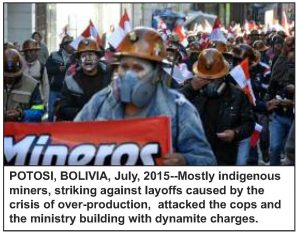
In Latin America, indigenous people were enslaved from the second voyage of Columbus in 1493 until the 1820s, when most Latin American countries won independence from Spain.
The abolition of African slavery began in 1791 when Haitian slaves organized a mass uprising against their French masters. They declared Haiti an independent republic ruled by ex-slaves after fighting thirteen years against French, English and Spanish imperialists who tried to re-enslave them. Indigenous people and descendants of en- slaved Africans still face vicious racism through- out the Americas.
Indigenous people and descendants of enslaved Africans still face vicious racism in Mexico, the Caribbean, Central and South America.
The poorest and most oppressed people from Chile to Mexico are those living in isolated indigenous communities. They also have a long history of struggle, although it has often takes the form of nationalism instead of a united class struggle for communism.
In 1932, mostly indigenous farmworkers in El Salvador, led by the Communist Party, rebelled against the military dictatorship. This uprising was crushed by the Salvadoran military, who massacred between 10,000 and 30,000 people, nearly wiping out the Pipil people.
The slave traders took most of the Africans they had kidnapped to Brazil and the Spanish colonies. Rebellions shook the entire slave system–the most famous was Quilombo da Palmares in Brazi where escaped slaves built a multi-racial society where everything was held in common.
The work of enslaved Africans was crucial to Brazil and Cuba’s production of coffee and sugar cane for the international capitalist market. That’s why the rulers of these countries were the last to abolish slavery: Cuba in 1886 and Brazil in 1888.
In Mexico (which abolished slavery in 1820) and elsewhere, many have denied the existence of an African slave trade. Nevertheless, black workers in Latin America are more often poorer and have less schooling, shorter lives and higher infant mortality than whites.
The old communist movement did not make a priority of fighting racism. Therefore the masses have a limited understanding of racism as something inherent to capitalism-imperialism.
Communism, Not Socialism, Can End Racism
In five hundred years of heroic struggle by indigenous and African people in Latin America, the most successful in consciously addressing the racial question has been Cuba.
The 1959 revolution promised to end discrimination against black workers in housing, education, health care and jobs. It made significant progress in literacy, health care, and opening the professions.
However, Cuban socialism, like all socialism, is state capitalism. This guaranteed that those disadvantaged by the legacy of racism rapidly fell further behind.
More recently, the transition from state capitalism to market capitalism has eroded these temporary gains. Racism against black workers in Cuba has worsened. They are much more likely to be stopped by the police. By 2005 they had double the unemployment rate of whites.
The International Communist Workers’ Party in Latin America is learning from the experiences of comrades in South Africa, India, the US and elsewhere that the fight against racism is crucial to the fight for communism.

